09:33N 78:57W Porvenir San Blas Islands

Toucan
Conor & Marion Wall
Mon 9 May 2011 19:46
|
The Rosario Islands were not meant to be explored by us, just a place to
drop the anchor for the night on the way to the San Blas Islands but making our
way into the anchorage certainly produced a lot of interest in all the crew.
Houses on stilts, houses that took up an entire small island, modern houses with
private docks, old traditional buildings made of wood and straw and some shanty
dwellings. All shapes and sizes.
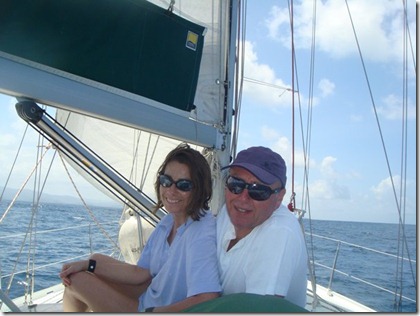 Two new crew members. Maria and Neil
We dropped the anchor to the East of Isla Grande but were asked to move
shortly after by Simon the chief boat boy who said that we might be obstructing
the police launch that passed through that spot on a regular basis. He was right
and we were glad we had moved as strictly speaking we had checked out of
Colombia coupled with the fact that we needed permission to visit the Rosario
Islands and did not have the permission to stop there. Shortly after arriving a
local in a dug out canoe came alongside and wanted us to buy some coconuts we
declined but couldnât resist the lobsters and crabs from his friend and Maria
made an excellent negotiator.
 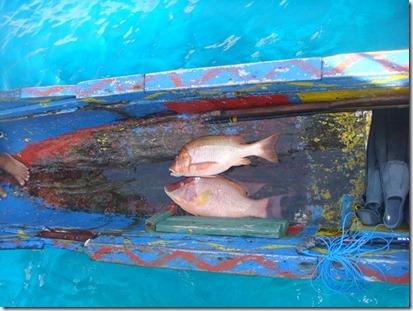 Some tasty
lobster
Fish in the bottom of the dugout.
Neil and I took a little explore in the dinghy and found a group of day
visitors, on a dive trip from the mainland diving on something. When we asked
them what was of such interest they told us that there was a small plane on the
bottom in about 15 meters of water. We couldnât resist and joined them with our
masks and fins. It was a bit of an eerie feeling as the plane was in pretty good
condition considering it had been on the bottom for a long time. We never found
out the story of the plane crash.
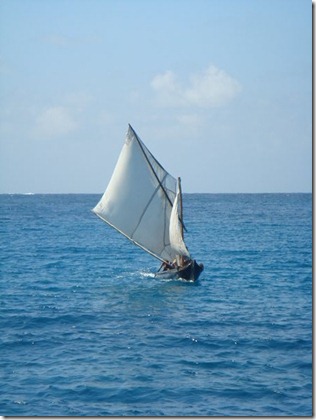 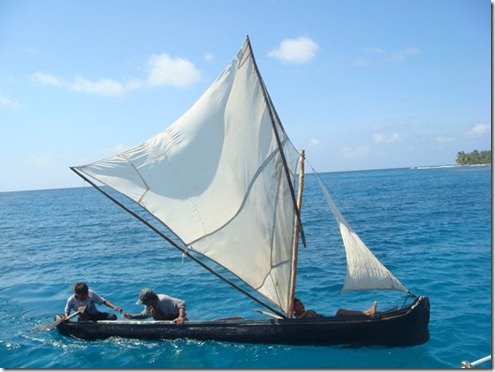 Being greeted at the San Blas islands by more boys selling fish and
lobsters from a dugout canoe with sail.
We left early the next morning for the overnight sail to the San Blas.
Winds were light for the most part although the seas were somewhat choppy. Full
moon made it a pleasant passage and we arrived the following day at the eastern
end of the San Blas at the group of Islands known as Ingles Cay.
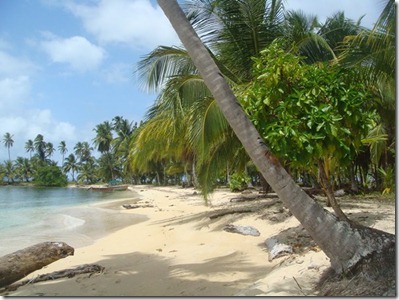 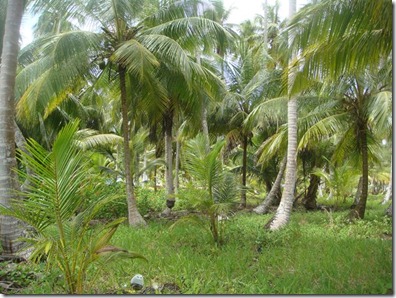 The San Blas Islands, over 350 islands, are made up of a long chain of Cays
and Archipelagos that run parallel to the coast of Panama for almost 100 miles.
Here the people known as the Kuna Indians live much the same as they have done
for hundreds of years having preserved their traditions better than any other
American tribe. They control their own destiny although they are part of Panama
and none of their tribe is allowed to marry outside the Kuna Yala tribe. Their
primitive life style was a bit of a shock to our system as it was the first time
on our sailing travels that we had come upon such primitive people. Marion and I
crossed Africa by car, Dublin to Cape Town, in the late 70âs so we know all
about primitive but we had not experienced it in our sailing career, no doubt
there will be more to come once we reach the Pacific. The Kuna Indians are
physically small rivalled in tribal shortness only by the Pygmies in
Africa.
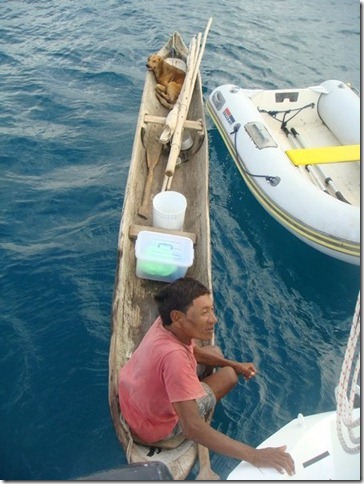 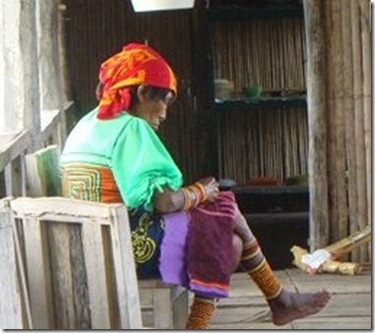 Kuna Indian in dugout canoe and Kuna woman making a
mola.
The anchorages in the many Cays with white sandy coral beaches were as nice
as Iâve seen anywhere with âout of the wayâ spots where you could drop anchor
and be the only one for miles. However as our time was limited by the fact that
Maria and Neil only had a total of two weeks holidays and would need to be back
in Panama City for the flight home we spent our time visiting the more popular
anchorages which were generally the more beautiful. The snorkelling was very
good as you would expect in crystal clear water. We even managed a party with a
bunch of the other cruising boats on one of the Islands on one of our
nights.
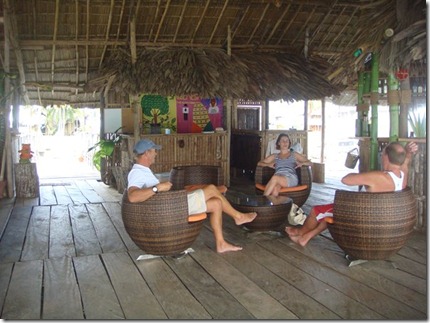 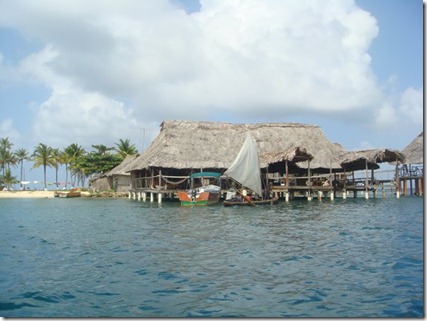 Probably the most expensive restaurant in the whole of the San
Blas, all to ourselves.
Once again on arrival in Panama we were obliged to do Customs and
Immigration. This happened at a place called Porvenir which is the administrive
island for the Kuna Indians. The Island, exactly the size of the airstrip, had
half a dozen or so buildings on either side of the airstrip and thatâs all. One
of the buildings was for the officials, one is a restaurant another a hotel of
sorts for those stranded on the island from lack of flights and a few others
including a shop that sold very little, but did have fresh bread.
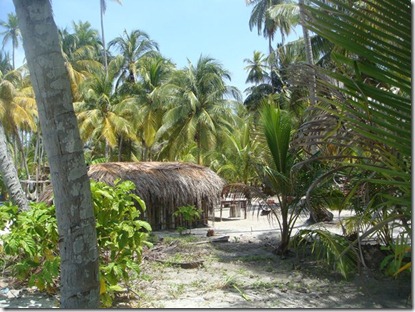 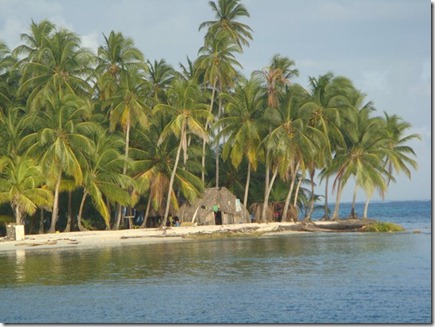 Some examples of homes of the Kuna Indians on remote
islands.
As Maria and Neil did not have a flight booked they asked to be put on the
waiting list for the small plane that landed each morning at 0600. Unfortunately
our timing coincided with a holiday and when the 20 seater arrived the following
day there was no room. Our friends decided to hitch a boat trip to the mainland
some 15 to 20 miles to a village where they would find transport to Panama city.
Needless to say they made it.
 The first attempt at rescue
Whilst we were in Cartagena we heard of an attack on a sailor who was
killed and dumped over the side. We hadnât paid too much attention as this was
not the kind of news we wanted to hear. The day before Maria and Neil were
leaving the San Blas islands we heard of a boat that was on a reef at the island
with the airstrip and an American boat called Aka were going to try to rescue
her and wanted help. Obviously we obliged and in the process discovered that
this was the very same boat that the killing took place on. The person
responsible was in police custody and the boat had been in their possession.
Remember that this is a primitive area and they knew nothing about anchoring
yachts, hence she ended up on a reef and they were not bothered. The American,
in touch with the dead manâs family had offered to try to save the boat. A
gallant effort was made and almost succeeded but were beaten by the darkness.
After Maria and Neil had left a second attempt was made and was successful. The
American was about to tow the yacht to another island with a safer anchorage but
just as he was about to set off the police arrived and took her back into their
custody. Evidence in a murder trial. Whilst on board I saw at least two holes
that could only have been made by a bullet, one in the upturned dinghy on the
foredeck and another in the coachroof. Not a good feeling.
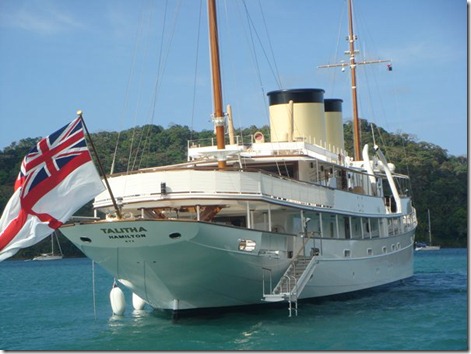 One of our neighbours at Porvenir, in her day was the largest
privately owned yacht in the world.
Marion and I then went to explore some of the other islands as we now had
time on our hands and no deadlines to meet for the first time in what seemed a
long while. We remained in the San Blas for another week before heading towards
the canal to a place called Portabello. A pretty little place with some
interesting old fortifications left over from the Spanish. We stayed here two
nights before moving on to Colon and the entrance to the Panama
Canal. |